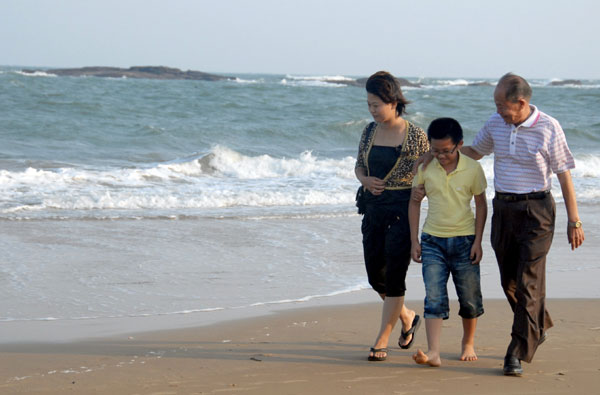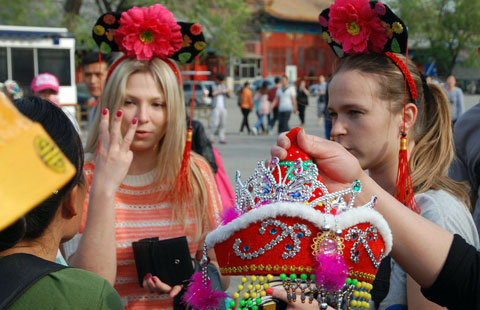Couples tie knot across Straits
By Sun Li and Hu Meidong in Jinjiang, Fujian ( China Daily ) Updated: 2013-08-09 08:24:19Love finds ways to cross differences, report Sun Li and Hu Meidong in Jinjiang, Fujian.
Hong Shuangfei is often reluctant to discuss her marriage, even though it's more than two decades since she tied the knot. The 39-year-old's reluctance stems from the fact that recalling the circumstances of the wedding can still prompt self-conscious giggles.
 |
|
Hong Shuangfei, with her son and father, walks on the beach at her hometown in Weitou, Fujian province. She travels from Kinmen regularly to visit her parents. Provided to China Daily |
"My parents initially opposed the marriage, and it was as though I'd won a game when they finally agreed," she said, laughing.
The native of Weitou village in Fujian province first met Chen Ying-chao, who hails from Kinmen county in Taiwan, in 1992. Later that year, they took the plunge and Hong became the first woman from her village to marry a man from Taiwan.
The proximity of Weitou and Kinmen, and the shared fishing grounds, inevitably result in friendships springing up, and people from Taiwan regularly drop by to visit the mainland village.
"My husband was a regular guest of my father, and that was how we knew each other," Hong said.
Although her father, Hong Jiancai, deemed Chen, who sold fishery products, to be a "good and able lad", he had grave reservations about the proposed marriage.
His concerns stemmed from the fact that for many decades, Weitou was regarded as a fortress against Taiwan.
One-China policy
In the 1950s, the village was of immense strategic importance to the defense of the mainland in the event of an artillery attack by the Kuomintang, which fled to Taiwan in 1949 in the wake of their defeat in the Chinese civil war (1945-49). Indeed, in 1958 the village was almost reduced to rubble by a massive bombardment.
 |
|
Some of the 35 women from Chongqing who have married men from Taiwan. Provided to China Daily |
Hong Jiancai, a war hero and former militia leader, was worried that cross-Straits relations would become tense and fractious and have serious ramifications for his family. "If a war occurred someday, would my role as a former mainland soldier jeopardize my daughter's situation in Taiwan? A conflict would probably mean that I would never see my daughter again," he recalled.
When the two sides reached a consensus in 1992, in which both agreed to abide by the one-China policy, Hong Jiancai began to bank on peaceful relations and gave the green light for his daughter to marry Chen.
However, his wife, Jiang Meili, argued that cultural differences would make life in Kinmen hard for Hong Shuangfei. She was also concerned that she would lose contact with her daughter because of the difficulties experienced by mainlanders who wanted to travel to Taiwan.
"I allied with my father to convince my mother that things wouldn't be that bad," said Hong Shuangfei, adding she promised to visit her mother regularly, irrespective of the inconvenience.
"As it turned out, things were really not bad at all," she said.
The links between Weitou and Kinmen are deep; the forefathers of many Kinmen residents hailed from southern Fujian and so the language, food and culture are similar. "Even our god is the same. We all worship Mazu, the Chinese goddess of the sea," said Hong Shuangfei. However, she remembered that one of the few problems she encountered after relocating was that some people in Taiwan didn't understand the mainland very well.
"Many people came to check on me and were surprised that I actually looked nice. They thought people from the mainland were all hillbillies," she said, adding that she wanted to take them to the mainland to see the reality for themselves, but was discouraged by the travel difficulties.
Unlike Kinmen residents, who could travel to the mainland by sea as long as they owned a boat or fishing license and an ID card, people from Weitou had to apply for official approval before traveling.
If approval was forthcoming, prospective visitors had to travel to the coastal city of Xiamen, then fly to Hong Kong and transfer to another flight to Taipei before finally arriving at Kinmen. The seemingly straightforward journey usually lasted two days.
|
|
|
|
|
|
|
|


















 Op Rana
Op Rana Berlin Fang
Berlin Fang Zhu Yuan
Zhu Yuan Huang Xiangyang
Huang Xiangyang Chen Weihua
Chen Weihua Liu Shinan
Liu Shinan